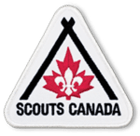Scouts Canada
| Scouts Canada | |||
|---|---|---|---|
|
The Scout fleur-de-lis and the maple leaf of the flag of Canada with two sticks to create a stylized tent or campfire in a stylized badge[1] | |||
| Headquarters | Ottawa, Ontario[2] | ||
| Country | Canada | ||
| Founded | 1914, incorporated 12 June 1914[3] | ||
| Founder | The Boy Scouts Association (United Kingdom) | ||
| Membership | |||
| Chief Scout | Terry Grant[5] | ||
| Patron Scout | David Lloyd Johnston[6] | ||
| National Commissioner | John A. Estrella[7] | ||
| National Youth Commissioner | Caitlyn Piton [8] | ||
| Executive Commissioner and CEO | Andrew Price[9] | ||
| Affiliation | World Organization of the Scout Movement | ||
|
| |||
|
Website Scouts Canada | |||

   | |||
Scouts Canada is a Canadian Scouting association providing programs for young people of all genders aged 5 to 26, with the stated aim "to help develop well rounded youth, better prepared for success in the world.".[10] Scouts Canada, in affiliation with the French-language Association des Scouts du Canada, is a member of the World Organization of the Scout Movement (WOSM). 2015-16 youth membership stands at 61,438,[4] a 5% decline from 64,693[11] in 2014-15. Over the same period, volunteer numbers stabilized with 20,717 in 2015 and 20,756 in 2016. This is a significant decline from its 1965 peak of 288,084 youth and 33,524 volunteers.[12]
Values
Scouts Canada's programs are based on three principles:
- Duty to God
- Duty to Others
- Duty to Self[10]
Scouts Canada's programs are co-educational and it states it is committed to diversity.[13][14] Scouts Canada has a policy not to discriminate for reasons of gender, culture, religious belief or sexual orientation.[15] Although Scouts Canada's principles requires a basic spiritual belief, it states that members are not required to subscribe to a religion or belief in God.[16]
History
For the history of the Scouting Movement in Canada outside of Scouts Canada, see Scouting and Guiding in Canada#History of Scouting in Canada.
Scouts Canada states "There is evidence that a few Scouting groups started up in Canada in 1907".[17]
In his 1981 book, 75 Years of Scouting in Canada Robert Milks, the late Scouts Canada archivist, indicated that the first Scout groups in Canada were founded in 1908. St. Catharines and Merrickville are mentioned as among the locations of the first troops.[18] Boy Scouts and the Scout Movement were well established in Canada before Scouts Canada or its parent organization, The Boy Scouts Association of the United Kingdom were formed.[17][18]
The Boy Scouts Association was formed in the United Kingdom in 1910 and incorporated in 1912. It has been claimed that its founder, Baden-Powell, wrote to Earl Grey, the Governor General of Canada in 1910 and asked him to organize Scouting in Canada. A branch of The Boy Scouts Association was established in Canada under The Boy Scouts Association's Overseas Department. The Canadian General Council of The Boy Scouts Association was incorporated by an Act of the Canadian Parliament on June 12, 1914. The Canadian General Council continued to be represented internationally by The Boy Scouts Association of the United Kingdom until 30 October 1946, when the Canadian General Council became a direct member of the Boy Scout World Conference, now the World Organization of the Scout Movement. The organization continued to be a branch of The Scout Association of the United Kingdom until 2007. The Canadian General Council of The Boy Scouts Association changed its name to Boy Scouts of Canada by an amendment to its incorporating Act of Parliament. In 1976 the Scouts Canada logo was introduced and the organization, by its By-laws, adopted the name Scouts Canada. In 2007, The Boy Scouts of Canada changed its name to Scouts Canada.[19][20]
In 1972, Scouts Canada began accepting female participants as part of its Rover Section. This was expanded in 1984 to include the Venturer Section. In 1992, co-ed Scouting was an option for all program sections and became policy for all sections in 1998.
Organizational structure
Scouts Canada is governed by a Board of Governors. Administration of the organization is divided into twenty Councils, each administering a whole province or large part thereof. The national body, Councils, and their respective Areas are organized around a key-three which include a Scouter, Youth, and Staff member[21]. The national body is made up of a National Commissioner appointed by the Voting Members, a National Youth Commissioner appointed by the Voting Members, and an Executive Commissioner appointed the Board of Governors.
The Council key-three is made up of a Council Commissioner appointed by the National Commissioner, a Council Youth Commissioner appointed by the National Youth Commissioner, and a Council Executive Director appointed by the Executive Commissioner. Council Commissioners in consultation with their respective key-three furthermore appoint their management teams to manage the interests of the council. All positions are advertised publicly and a selection committee interviews members based on skill set.[22] The Area key-three is made up of an Area Commissioner appointed by the Council Commissioner, an Area Youth Commissioner appointed by the Council Youth Commissioner, and an Area Support Manager appointed by the Council Executive Director.
Scouts Canada is affiliated with Association des Scouts du Canada.[23]
Under the World Organization of the Scout Movement's constitution, only one organization is recognized in each country.[24] Canada is the only country in which this recognition is held jointly.[25] Many other countries also have more than one Scouting organization and some of these have formed national federations which are the WOSM members. Scouts Canada and L'Association des Scouts du Canada send a joint delegation to meetings of the World Organization of the Scout Movement; this is coordinated through the Committee on Cooperation.
The "Patron Scout" of Scouts Canada is David Johnston, the current Governor General of Canada[26]. From 1910 to 1946, the position of Chief Scout for Canada and, from 1946 to 2013, the position of Chief Scout of Canada were held by successive Governors General of Canada.[27] On 19 April 2013, the Scouts Canada Board of Governors appointed Terry Grant as Chief Scout of Canada.[28]
Programs
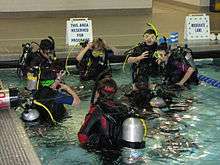
Full-time programs
The organization divides programs by participant age. The Beaver program is for participants from five to seven. The Wolf Cub program is for participants from eight to ten. The SCOUTSabout program is for participants from five to ten. The Scout program is for participants from 11 to 16. The Venturer program is for participants from 15 to 17. The Extreme Adventure program is for participants from 14 to 17. The Rovers program is for participants from 18 to 26.[29]:1 of Section 5000
Beaver Scouts
Beaver Scouts is a Scouting program aimed at children between ages 5–7, that runs between September and May. The Beaver Scout uniform includes a bucket hat, a neckerchief, a neckerchief slide, and a vest. Activities include crafts, games, sports, music, hikes, and camping. Spiritual fellowship is also an activity in the program. Their motto is "Sharing Sharing Sharing".[30]
Cub Scouts
The Cub Scouts program is a program aimed at children ages 8 to 10, that runs September to June. Activities of the program include hiking, camping, and water activities such as canoeing and kayaking. The program's purpose is to encourage members to "try new and more challenging activities". Its motto is "Do your best".[31]
Scouts
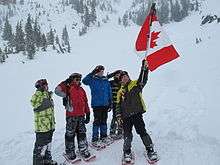
The Scout program of Scouts Canada is aimed at youth between 11 and 14 years old, that runs weekly September to June, with major week-long activities in the summer months. Activities include outdoor activities, camping, and hiking, as well as participation in youth forums. It claims that its purpose is "having fun while gaining valuable leadership skills and self-confidence".[32]
Venturer Scouts
The Venturer Scout program is a program intended for teens between 14 and 17 years old, that that runs weekly September to June, with major week-long activities in the summer months. Its stated aim to "offer exciting, real life, hands-on experiences for youth". Its activities include hiking, camping, and more advanced training programs: white water kayaking / canoeing, mountaineering, week-long expeditions in National parks and international activities including service projects.[33]
Rover Scouts
Rover Scouts is the eldest youth program in Scouting, aimed at teens and young adults between 18 and 26 years old, with a regular meeting schedule that lines up with the college / university academic year. Activities include "high adventure activities" ranging from multi-week expeditions with increasingly-difficult challenges, taking on leadership roles working with younger sections, and assisting with or running service projects at a local / national / international level.[34]
Vocational programs
- Medical Venturers/Medical Rovers (Medvents/Medrovers) is a new program that consists of Venturers and Rovers that learn and provide first-aid. Medical Venturers have been credited with saving lives in Toronto by using an AED to assist a patient in cardiac arrest.[35]
- Fire Venturers learn basic fire fighting skills while working with fire departments[36]
- Police Venturers learn firearm safety, crowd control, and similar skills while working with police departments[37]
- Service Corps Venturers/Rovers provide community service within the Scouting Community as well as outside organizations including Heritage Canada, The Ottawa Hospital Foundation, The Ottawa Food Bank and The Royal Canadian Legion's Dominion Command.
In the Ottawa region (as a part of Scouts Canada's Voyageur Council), the Voyageur Council Service Alliance (VCSA) includes MedVents, PoliceVents and the Service Corps. Among its many efforts, the VCSA: Service Corps assists the Canadian Heritage (previously National Capital Commission) with on-the-ground services (notably the Lost Children Service) during events such as: Canada Day, Winterlude (on-canal patrols to assist the public), Lighting the Capital at Christmas, the spring Tulip Festival, and others.
Part-time programs
Scouts Canada also has programs designated as Part-Time Programs.
ScoutsAbroad
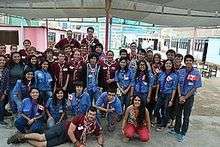
ScoutsAbroad is a program which was created to support the Canadian Brotherhood Fund.[38] Scouts in wealthier countries like Canada help Scouts in developing countries help themselves on the road to self-sufficiency. The Canadian Brotherhood Fund provides through grants, “seed money” for many international development projects.[39] The ScoutsAbroad program also promotes youth involvement in learning about their world through penpal programs, international events, and international exchanges.[38]
International Development Projects
International Development Projects are known internally as Brotherhood Projects which stems from the Canadian Brotherhood Fund. Groups of Scouts in developing countries develop and carry out projects to improve their own lives and the future of their communities. In some cases, members of Scouts Canada participate in travelling abroad to assist in carrying out portions of a project. There has been over 13 projects completed since 2007.[38]
SCOUTSabout
The SCOUTS about program aims to fulfill Scouting's mission with those children who are not members of a Scouting organization.[40] SCOUTSabout is implemented in 3-month long modules, often after school, to appeal to those families who do not want or can not commit to year-round activities.[40][41] Theme based, the focus is on structured play and learning by doing without uniforms, badge programs and ceremonies.[40][41] SCOUTSabout is for children between 5 and 10 years old.[40][41]
Extreme Adventure
Extreme Adventure offers the opportunity for young people aged from 14 to 17, to plan and participate in a variety of short-term adventure-based activities.[41] Example activities are: hiking, long-term camping and travelling abroad to participate in humanitarian projects.[41] The program seeks to realise Scouting's mission with non-members.[40] There is no uniform and are no ceremonies associated with this program.[40] It is designed to include development of leadership skills and self-esteem and the participation in community projects that is also offered through the ordinary programs.[40] Extreme Adventure is based on the Venturer Amory Adventure Award concept.[40]
Major youth awards
Scouts Canada has several major youth awards which include:
- The Chief Scout's Award was established in 1973 as the top award in the Scout section.
- The Queen's Venturer Award is the top award in the Venturer section. In 1968, the normal upper age for members of the Scout section was reduced from 17 to 14 and the Venturer section was created for ages 14–17. As part of these changes, Queen's Scout rank was replaced with the Queen's Venturer Award.
- The Amory Adventure Award is awarded to the Venturer company that exhibits the most initiative in conceiving, planning, and executing an outdoor adventure.
- The Medal of the Maple was created in 2007 and is awarded for distinguished youth service and excellence within the Scouting Movement.[42]
Camps
Scouts Canada operates over 125 camps across Canada.[43] Popular camps include Camp Impeesa, Haliburton Scout Reserve, Camp Byng and Tamaracouta Scout Reserve. The Tamaracouta Scout Reserve is among the oldest continually operating Scout camps in the world.[44]
The following camps in Canada have the WOSM Scout Centres of Excellence for Nature and Environment (SCENES) designation:[45]
- Blue Springs Scout Reserve, Milton, Ontario
- Camp Nemo, Burlington, Ontario[46]
- Attawandaron Scout Reserve, Pork Franks, Ontario[47][48]
- Haliburton Scout Reserve, Haliburton, Ontario (south of Algonquin Park)
The SCENES designation identifies each of these locations as a property that is operated and managed according to the highest environmental standards, committed to protecting its ecosystems and minimizing its environmental impact.[49] They also provide hands-on educational activities for youth and training opportunities for leaders, enabling all to engage with nature and become empowered to make their own personal commitment to the environment.[50]
Major events
Canadian Scout Jamboree
The Canadian Scout Jamboree or CJ is a national jamboree run by Scouts Canada for Scouts and Venturers from across Canada. They have been held in 1949, 1953, 1961, and about every four years since 1977.
ADVenture
ADVenture is run by Scouts Canada for members of the Venturer Scout Section. Created to further differentiate Scouts and Venturers, ADVenture provides a different style of national camp for an older age group.
- 2012: 1st Venturer ADVenture, Haliburton Scout Reserve, Haliburton, Ontario
- 2014: 2nd Venturer ADVenture, Camp Nor’ Wes, Newfoundland [51]
World Jamborees hosted by Scouts Canada
- 8th World Scout Jamboree, 1955, Niagara-on-the-Lake, Ontario; first World Jamboree held outside of Europe
- 15th World Scout Jamboree, 1983, Kananaskis, Alberta
- 24th World Scout Jamboree, 2019, The Summit Bechtel Family National Scout Reserve in Glen Jean, West Virginia. Scouts Canada will co-host along with the Asociación de Scouts de México and the Boy Scouts of America.
Canadian Moots
Moots are for Rover Scouts.
- 1st Canadian Rover Moot: 1951, Blue Springs, Ontario 538 Attend[52]
- 2nd Canadian Rover Moot: 1956, Sussex, New Brunswick
- 3rd Canadian Rover Moot: 1959, Banff, Alberta
- 4th Canadian Rover Moot: 1962, Mekinac, Quebec Around 1000 attend[53]
- 5th Canadian Rover Moot: 1966, Parksville, British Columbia
- 6th Canadian Rover Moot: 1970, Birds Hill Park, Winnipeg, Manitoba
- 7th Canadian Rover Moot: 1974, Camp Samac, Oshawa, Ontario
- 8th Canadian Rover Moot: 1978, Camp Impeesa, Pincher Creek, Alberta
- 9th Canadian Rover Moot: 1982, Camp Wetaskiwin, St. Catharines, Ontario 531 Attend[54]
- 10th Canadian Rover Moot: 1986, McLean Park, Langley, British Columbia
National Youth Network
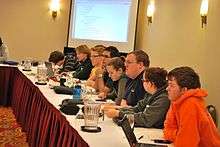
The National Youth Network consists of Scouts Canada youth from across the country. The purpose of the National Youth Network is to ensure meaningful youth involvement in all Scouts Canada decisions, support the organization of Council Youth Networks, and encourage youth to take on leadership roles.[55]
The National Youth Network typically consists of one National Youth Commissioner, three Assistant National Youth Commissioners and 20 Council Youth Commissioners.[55]
Projects
Develop and promote FLEX, FAST and FOCUS – Scouts Canada’s Youth Leadership training programs for Cub Scouts, Scouts, and Venturer Scouts. The Youth Network also maintains and adjudicates the Medal of the Maple for Distinguished Youth Service.[55]
The National Youth Network is only a small part of the larger Scouts Canada Youth Network that is made up of the National Youth Network, the Council Youth Networks, the Area Youth Networks and other youth representatives across Canada.
Initiatives
Scouts Canada is in the process of actively increasing its membership nationwide.[56] This process includes more direct program support to leaders; building on such things as a partnership with the Robert Bateman Foundation, a program help line,[57] an award-winning Climate Change program[58] and a variety of camping programs across the country.[59][60][61]
Good Turn Week
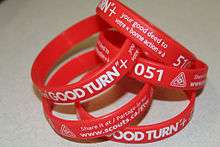
Good Turn Week is an initiative spearheaded by Scouts Canada National Youth Network that follows the principles of Scouting, which teach youth to always do unto others as they would do unto you. The campaign is designed to encourage Canadians to do 'good turns' for each other.[62]
In addition to the original initiative, the Good Turn Week Community Project Challenge was created to help Sections, Groups, or Councils get their Good Turn ideas off the ground. Scouts Canada selected up to 15 projects nationally that would be funded up to $2,000 per project.[63][64][65]
2011 uniform redesign
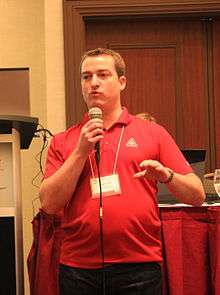
As part of this plan, Scouts Canada re-designed its uniforms with models designed by Joe Fresh Style. Beavers uniforms changed only in colour and fabric. While the major changes in the uniform design are seen in the changes to the style of the button-up shirt and its colour from khaki to grey, green, blue, or red, for Cubs, Scouts, Venturers, Rovers/Leaders respectively. It also offers a technical T-shirts for moisture management.[66] As part of the re-design the sash was eliminated as a uniform component, which has resulted in smaller proficiency badges being made for Cub Scouts and Scouts to sew directly onto their uniforms.[66] The new design received high marks from Fashion magazine Flare stating that the new uniforms are both stylish and comfortable.[66] The material for the red uniform shirt (not the activity golf shirt) changed in mid-2016 due to performance issues.
The Canadian Path
Starting in 2013, Scouts Canada embarked on their first program revitalization since the 1990s. Following WOSM resolutions set out in the World Scout Youth Programme Policy,[67] to make programs relevant to the needs and demands of the current day's youth, the goal of the project was to do just that. Under development from 2014 until 2016, utilizing a gradual rollout process with many sections piloting the program, it formally launched in September 2016. The new approach takes notes from traditional Scouting practises and focuses around four main elements; Youth-led, Plan-Do-Review, SPICES, and Adventure. It allows youth to develop themselves along a common path (with section-specific themes) from Beaver Scouts up to and including Rover Scouts.[68]
Controversies
Organizational structure
Scouts Canada is governed, like all incorporated non-profit organization[69] by a Board of Governors. Each Council elects three Voting Members of whom at least one must be a youth. All members are able to vote for and or be nominees for Council Voting Members. At the National Annual General Meeting of Members, Voting Members elect the Board of Governors and the National Commissioner.[70]
There are Scouters, most notably members of an organization called SCOUT eh! who believe there is a lack of representation and lack of accountability of this governance structure.
Child protection
In 2012, the CBC ran a documentary suggesting that Scouts Canada had not always reported leaders who had sexually abused children to the police, relating to incidents that took place between 1960 and 1990.[71] Scouts Canada subsequently posted a video apology[72] followed by "a thorough, arms-length review of all records held by Scouts Canada on Leader suspensions or terminations that are related to abuse" by KPMG's forensic investigations unit.[73] The report from KPMG subsequently "found no systemic intent to cover up or hide incidents of abuse"[74][75][76]
Youth Protection
In the late 1990s , Scouts Canada modernized its screening practices for adult members to require a Police Record Check, with a Vulnerable Sector Check added in 2015-2016. As part of this screening, local volunteers interview applicants and check the multiple references they must provide as part of the Volunteer Recruitment and Development (VRAD) process.[77] Scouts Canada volunteers are prohibited from being alone with a youth member; two fully screened volunteers are required to be present at all times with any youth.[78] In the event that a volunteer is suspected of misconduct, Scouts Canada policy requires that they are immediately suspended and the relevant authorities are notified with all information shared as part of an investigation into the volunteer's actions.[77][79]
Scouts Canada provides with some of its handbooks (and online), a booklet called How to Protect Your Children from Child Abuse: A Parent's Guide.[80] In addition, it is a badge requirement in the Scout program for parents and youth to review a portion of How to Protect Your Children from Child Abuse: A Parent's Guide[81]
Relations with other Scout associations
In 1999, the Baden-Powell Service Association Federation of Canada (B-PSAFC) was ordered by Industry Canada "to take the word 'scout' out of its title." Scouts Canada also sought for the removal of the name Baden Powell, going on to say "...there's one scouting association in Canada, one in the world, every country has only one that's how Baden Powell set up scouting..." because "[Baden Powell] felt anything else would dilute the program, cause confusion and hurt the programs for young people." [82] The World Organization of the Scouting Movement (WOSM) website reinforces this policy which states, "There can only be one [National Scout Organization] per country." [83]
Councils
Scouts Canada has 20 geographical Councils that encompass the entire nation. Each Council is divided into multiple service Areas, that are in turn composed of individual Scout Groups in each community across Canada.
See also
References
- ↑ "Brand Centre - The Scouts Canada Brand Guide". scouts.ca.
- ↑ "Contact Scouts Canada". Scouts Canada. Retrieved 19 February 2012.
- ↑ "Scouts Canada History". Scouts Canada. Retrieved 19 February 2012.
- 1 2 3 4 "Scouts Canada Annual Report 2015-16" (PDF). Scouts Canada. Retrieved 15 November 2016.
- ↑ "Chief Scout". scouts.ca.
- ↑ "Board of Governors". Scouts Canada. Retrieved 19 February 2012.
- ↑ "Scouts Canada". Scouts Canada. Retrieved 15 May 2014.
- ↑ "Scouts Canada". Scouts Canada. Retrieved 18 November 2015.
- ↑ "Scouts Canada's Board of Governors Announces New CEO". Scouts Canada. Retrieved 27 March 2014.
- 1 2 "Values". scouts.ca.
- ↑ "Scouts Canada Annual Report 2014-15" (PDF). Scouts Canada. Retrieved 23 September 2016.
- ↑ Morland, Liam. "Membership Retention in Scout Troops" (PDF). ScoutDocs. World Organization of the Scout Movement. Retrieved 24 September 2016.
- ↑ http://www.scouts.ca/ca/frequently-asked-questions | Scouts Canada FAQ, Does Scouts Canada Admit Both Boys and Girls?
- ↑ http://www.scouts.ca/ca/frequently-asked-questions | Scouts Canada FAQ, Do You Have to Believe in God to Join Scouts Canada?
- ↑ http://www.scouts.ca/ca/frequently-asked-questions | Scouts Canada FAQ, Are Homosexuals Allowed to Join Scouts Canada?
- ↑ http://scouts.ca/ca/frequently-asked-questions | Frequently Asked Question | Scouts Canada
- 1 2 "Scouts Canada History". Scouts Canada. Retrieved 2013-05-01.
- 1 2 Milks, Robert (October 1981). 75 Years of Scouting in Canada. Ottawa: Scouts Canada. pp. 9–11.
- ↑ "Bill s-1001, Text of Bill". parl.gc.ca.
- ↑ Scouts Canada Official Name Change Legislation
- ↑ Scouts Canada By-Laws, Policies and Procedures - Section 4000
- ↑ http://www.scouts.ca/bpp/bpp.pdf
- ↑ Original Agreement between Scouts Canada and L'Association des Scouts du Canada
- ↑ http://scout.org/sites/default/files/library_files/WOSM_Constitution_EN.pdf
- ↑ "L’origine de l’Association des Scouts du Canada - Association des scouts du Canada". scoutsducanada.ca.
- ↑ cite web |url=http://www.newswire.ca/news-releases/scouts-canada-and-lassociation-des-scouts-du-canada-partner-for-the-future-of-canadian-scouting-510808391.html%7Ctitle=Scouts Canada and l'Association des Scouts du Canada Partner for the Future of Canadian Scouting |publisher=Scouts Canada |accessdate=2017-05-30}}
- ↑ "Scouts Canada History". scouts.ca.
- ↑ Richard Watts. "Former star of Mantracker series takes on a new duty: Chief Scout". Times Colonist.
- ↑ By-law, Policies, and Procedures. Scouts Canada. September 2016.
- ↑ "Beaver Scouts".
- ↑ "Cub Scouts".
- ↑ "Scouts".
- ↑ "Venturer Scouts)".
- ↑ "Rover Scouts".
- ↑ http://torontoems.ca/ems-video/?p=1417
- ↑ "City of Toronto: Toronto Fire Services - Recruitment". Retrieved 31 January 2013.
- ↑ "Ottawa Police Venturers". Ottawa Police Service / Service de police d'Ottawa. Retrieved 31 January 2013.
- 1 2 3 "ScoutsAbroad". scouts.ca.
- ↑ Canadian Brotherhood Fund
- 1 2 3 4 5 6 7 8 Francis, Ross; Ian Mitchell (June–July 2002). "It's All About Mission" (PDF). The Leader. pp. 8–9. Retrieved 5 March 2007.
- 1 2 3 4 5 "Short-term Programs". Scouts Canada. Archived from the original on 6 February 2007. Retrieved 5 March 2007.
- ↑ The Medal of the Maple for Distinguished Youth Service
- ↑ "Camps". scouts.ca.
- ↑ http://que.scouts.ca/ca/camp-tamaracouta | Tamaracouta Scout Reserve Details
- ↑ "SCENES". scout.org.
- ↑ "Camp Nemo". swocamps.ca.
- ↑ "Camp Attawandaron". attawandaron.com.
- ↑ "Camp Attawandaron". swocamps.ca.
- ↑ http://scouts.ca/sites/default/files/scenes-cdn-requirements-2012.pdf
- ↑ "SCENES". scouts.ca.
- ↑ http://scouts.ca/adventure14/location.html
- ↑ . Youtube https://www.youtube.com/watch?v=yx-dEkeaeqE. Retrieved 10 April 2014. Missing or empty
|title=(help) - ↑ "The Shawinigan Standard - Google News Archive Search". google.com.
- ↑ . The Leader, December'82 https://www.facebook.com/photo.php?fbid=3775086290878&set=o.413566715342730&type=1&relevant_count=1&ref=nf. Missing or empty
|title=(help) - 1 2 3 "National Youth Network". scouts.ca.
- ↑ http://www.scoutingnow.org/
- ↑ program help line
- ↑ Climate Change Resources
- ↑ Chinook Council
- ↑ Greater Toronto Council
- ↑ Camp Tamaracouta
- ↑ http://www.scouts.ca/goodturn/about.php
- ↑ http://www.scouts.ca/goodturn/community-projects.php
- ↑ "Scouts give something back to the Lions Club during Good Turn Week". mykawartha.com.
- ↑ "Scouts Canada Launches Large-Scale Community Projects from Coast-to-Coast for 5th Annual Good Turn". newswire.ca. 30 April 2016.
- 1 2 3 Tamsin McMahon (25 March 2011). "Scouts Canada redesigns its uniforms". National Post.
- ↑ "World Scout Youth Programme Policy" (PDF). Scout.org. World Organization of the Scouting Movement. March 2014. Retrieved August 20, 2016.
- ↑ Canada, Scouts. "The Canadian Path - The Four Elements". The Canadian Path. Retrieved 2016-08-21.
- ↑ http://attorneygeneral.jus.gov.on.ca/english/family/pgt/nfpinc/not_for_profit_incorporators_handbook_en.pdf
- ↑ http://scouts.ca/bpp/en/bylaw2.pdf
- ↑ "Scouts Canada admits not all past sexual abuse reported to police". CBC News. 17 February 2012. Retrieved 18 February 2012.
- ↑ YouTube. youtube.com.
- ↑ Steve Kent (8 December 2011). "An Important Message Regarding Child and Youth Protection - December 8, 2011" (PDF). Scouts Canada. Retrieved 29 February 2012.
- ↑ http://scouts.ca/cys/sc-kpmg-report.pdf
- ↑ http://scouts.ca/cys/sc-kpmg-report-fact-sheet.pdf
- ↑ "Scouts Canada refers more than 100 sex abuse allegations to police". The Globe and Mail. Toronto. 25 June 2012.
- 1 2 Scouts Canada By-Laws, Policies and Procedures - Section 7000
- ↑ Scouts Canada. "Scout Canada’s Youth Protection Procedures and Guidelines" (PDF). Scouts Canada. Retrieved 29 February 2012.
- ↑ Scouts Canada. "Youth Protection". Scouts Canada. Retrieved 20 February 2012.
- ↑ "How to Protect Your Children from Child Abuse: A Parent's Guide" (PDF). Scouts Canada. Retrieved 20 February 2012.
- ↑ http://www.scouts.ca/sites/default/files/S-VoyageurPersonalDevelopment.pdf
- ↑ "Scouts organization ordered to change name". CBC News. 8 December 1999. Retrieved 15 March 2015.
- ↑ "Scout Organisations". World Organization of the Scout Movement. 15 March 2015. Retrieved 15 March 2015.
External links
